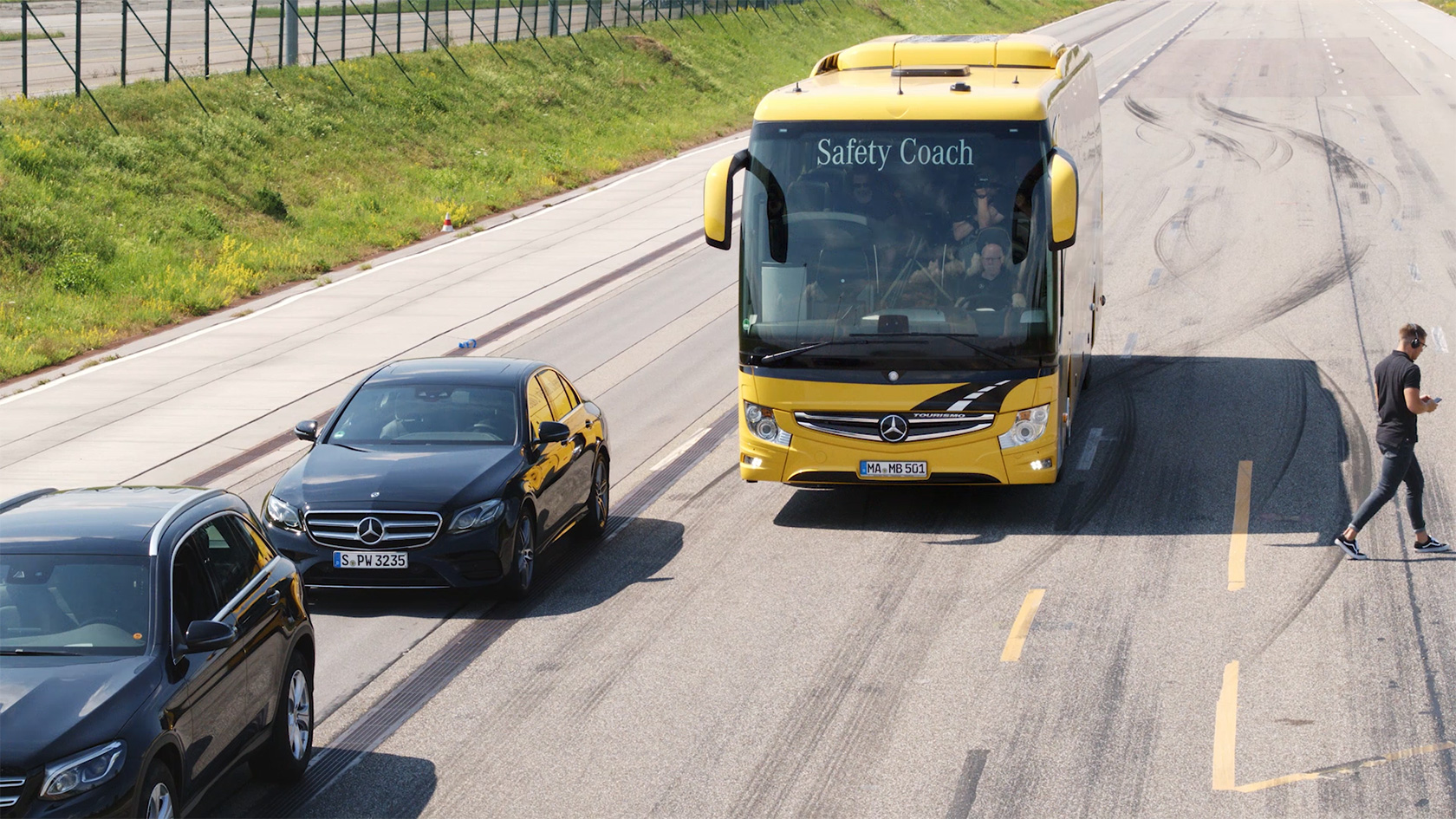From the anti-lock braking system to the new Active Brake Assist 6 (ABA 6) and Sideguard Assist 2 – almost all modern safety and assistance systems have their origins with Mercedes-Benz. They are part and parcel of an integral safety concept.

Omnibus Magazine
Evolution of safety.
Safety first.
Daimler Buses focuses on safety.
Safety first.
Wherever the journey takes you, in a Mercedes-Benz bus or coach, your drivers and passengers are in safe hands. It makes no difference whether the journey is a short distance through the city to work or school or in a long distance coach and on a holiday trip covering thousands of kilometres on motorways throughout Europe. Maximum safety is at the heart of the Mercedes-Benz brand. That’s why Mercedes-Benz has been supporting drivers for many years, constantly improving the range and effectiveness of our assistance systems – in so doing offering the best possible protection for all passengers and other road users. The focus is on active safety for accident prevention.
Innovations for greater safety.
From the anti-lock braking system in 1981 to the electropneumatic brake system (EBS) in 1997, the adaptive cruise control, Electronic Stability Program, Lane Assist and the continuous brake limiter in the last decade, to the turning assistant Sideguard Assist and the emergency braking system Active Brake Assist in increasingly effective and advanced versions – almost all modern assistance systems have had their world premiere on a bus or coach bearing the three-pointed star.
Integral safety concept.
For Mercedes-Benz, however, safety is more than just a series of individual measures: it is a comprehensive, integral safety concept. The associated claim is clearly formulated: as a premium brand, Mercedes-Benz wants to fulfil the most stringent of safety requirements and is forging ahead with its development activities in all areas. The integral safety concept comprises several components. It centres on a wide range of innovative safety equipment for specific vehicles and applications, with the aim of continuously improving active and passive safety. These range from safe driving to use in the event of danger and the mitigation of accident consequences to providing guidelines for rescue services.
“The aim of the integral safety concept is an ambitious one: to make accident-free driving a reality.”
This includes other measures such as OMNIplus driver training courses. The aim is for drivers to identify and avoid hazards in time. They are also shown how to react correctly in the event of an accident. Another key part of the concept involves informing passengers on how to use the on-board safety equipment – starting right from the beginning with putting on seat belts in the touring coach. But the concept also extends far beyond this to include responsible vehicle maintenance and the use of tried and tested genuine spare parts for servicing. The aim of the integral safety concept is an ambitious one: to make accident-free driving a reality.
Making long distance travel even safer: the Mercedes-Benz Tourismo.
With its standard equipment, the Mercedes-Benz Tourismo touring coach really sets the standard when it comes to safety. It's equipped with a host of innovative assistance systems. The standard emergency braking system Active Brake Assist 6 (ABA 6) is outstanding. Its new sensors make it even more powerful than its predecessor. ABA 6 detects moving or stationary people and cyclists in front of the vehicle and can initiate emergency braking independently. This means that accidents can be avoided even more reliably. The system covers the entire vehicle speed range and is active in the background.
The new radar-based turning assistant Sideguard Assist 2, which warns of the risk of collision with pedestrians and cyclists, is also part of the Tourismo's standard equipment. Previously only available for the door side, it is now also available for use on the driver’s side. Sideguard Assist 2 works hand in hand with the likewise new Frontguard Assist, which monitors the area immediately in front of the vehicle. Last but not least, the reversing camera, Lane Assistant (SPA), Traffic Sign Assist, Attention Assist (AtAs), the adaptive cruise control (ART) and the tyre pressure monitoring (TPM) in the Mercedes-Benz Tourismo touring coach provide more safety as standard, taking the strain off the driver. The optional 360° camera system and MirrorCam ensure a better overview of all situations.

Intercity buses from Mercedes-Benz: outstanding safety.
The safety level of the city and intercity buses from Mercedes-Benz is just as exemplary. Citaro, eCitaro fuel cell, CapaCity large-capacity regular-service buses as well as the Intouro and Conecto intercity buses are equipped as standard with a wide range of assistance systems to further improve safety and protect vulnerable road users.
These include the turning assistant Sideguard Assist 2 and the new Frontguard Assist. A reversing camera, Traffic Sign Assist, the tyre pressure monitoring system TPM and Attention Assist (AtAs) are also part of the standard equipment. Additional safety is ensured by the optional emergency braking assistant Preventive Brake Assist 2, the likewise optional 360° camera system (articulated buses: 270° camera system) and the MirrorCam, which is optionally available for all buses. The Intouro can also be optionally equipped with Active Brake Assist 6 (ABA 6).
All of this makes the Mercedes-Benz bus and coach range the true safety expert. Mercedes-Benz wishes you a pleasant and, above all, safe journey – wherever the road may take you.


